2. 江西省核工业地质局, 南昌 330046
2. Jiangxi Nuclear Industry Geological Bureau, Nanchang 330046, China
前人对钨矿物开展过大量研究工作(熊德信等,2006;Zahid et al., 2013;黄惠兰等,2015;Orhan,2017;刘善宝等,2017;Zhang et al., 2018),然而这些研究工作多集中于黑钨矿和白钨矿,事实上,含钨矿物远不止这两种。除了白钨矿与黑钨矿之外,还有许多矿物富钨。例如,我国湖南骑田岭花岗岩与癞子岭花岗岩及捷克Cínovec锡钨多金属矿床中均发现了富钨的骑田岭矿(杨光明等,1985;彭志忠等,1987;Breiter et al., 2017;Xie et al., 2018),其WO3含量高达30%以上;我国新疆阿尔泰伟晶岩(张爱铖等,2004)以及波兰Szklary伟晶岩(Pieczka,2010)中发现的铌铁矿族矿物WO3含量也较高(前者可达0.26%,后者高达3.82%);捷克Třebíč岩体中易解石的WO3含量可以达到1.37%,黑稀金矿WO3含量可达1.36%,氧铌钙铈矿WO3含量为1.16%(Škoda and Novák,2007)。除此之外,作为石英脉型黑钨矿床的典型代表,我国大吉山钨矿也发现了富钨的铌锰矿,其WO3含量高达7.90%(Wu et al., 2017);法国马西夫中部PUY-LES-VIGNES钨矿中同样发现了Nb-Ti-Y-HREE-W-U氧化物矿物,其WO3含量可以达到5.60%(Harlaux et al., 2015)。可见,不同程度的富钨是这类含铌矿物的重要特征。
钨矿床具有多种矿化类型,其中工业意义最大的钨矿主要为矽卡岩型和石英脉型钨矿。矽卡岩型钨矿床矿石矿物主要为白钨矿,而石英脉型钨矿床矿石矿物主要为黑钨矿(徐克勤等,1959;江西省矿产地质志编辑委员会,2015)。聚源钨矿是华南地区发现的为数不多的大型石英脉型白钨矿矿床之一,以矿石矿物主要为白钨矿区别于大多数石英脉型钨矿床,其平均WO3品位约为0.245%,WO3资源量约12.6万吨(江西有色地质勘查一队,2015①),达到大型规模。
① 江西有色地质勘查一队. 2015. 江西省崇仁县聚源钨矿储量核实报告
除了白钨矿和黑钨矿之外,聚源钨矿成矿过程中是否还结晶了其他含钨矿物呢?这些含钨矿物具有怎样的时空演化规律呢?笔者在详细的野外调查基础上,利用α径迹蚀刻、电子显微镜、扫描电镜以及电子探针等实验手段,对其钨矿石开展了钨矿物的精细矿物学的研究工作,在此基础上,探讨了聚源钨矿成矿过程中钨的矿物学行为。
1 矿床地质特征聚源钨矿地处江西中部,扬子陆块和华夏陆块交汇部位的中东段,是钦杭成矿带江西段的重要钨矿床之一(杨明桂和梅勇文,1997;余达淦等,2006)。矿区内出露的地层比较简单,主要为震旦系沅里组,泥盆-石炭系以及第四系衢江群。震旦系沅里组地层主要由石英砂岩与石英片岩组成;泥盆-石炭系地层主要岩性为炭质页岩、石英砾岩以及砂岩;第四系衢江群主要发育有红色砂砾岩和粗砂岩。区内发育的岩浆岩以燕山期花岗岩-花岗斑岩为主,侵入沅里组变质石英砂岩和石英片岩之中,出露面积不大,最长处不超过1300m,最宽处不超过1000m。矿区内断裂构造较为发育,北东向为主,其次为北西向(图 1)。
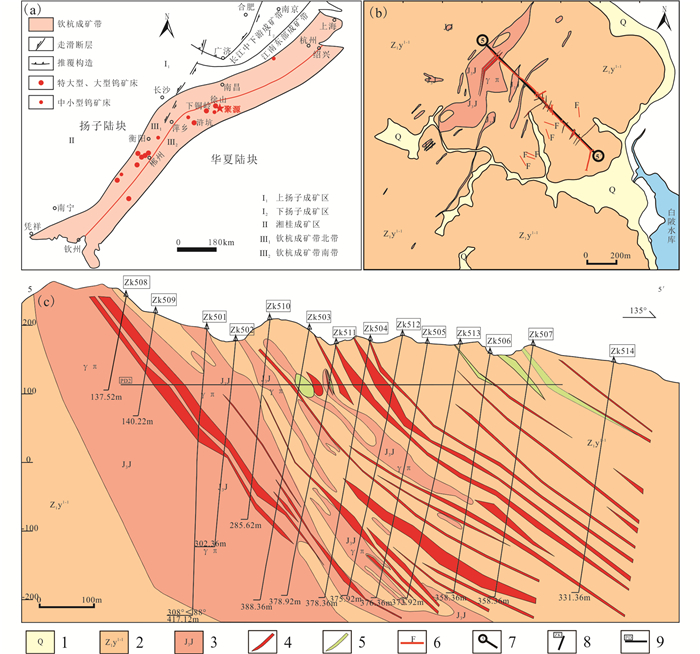
|
图 1 聚源钨矿地质简图(a, 据杨明桂和梅勇文,1997;李光来等,2011修改;b, c, 据江西有色地质勘查一队,2015修改) (a)钦杭成矿带钨矿床分布简图;(b)聚源钨矿矿区地质简图;(c)聚源钨矿5号勘探线剖面图. 1-第四系衢江群;2-震旦系沅里组下段变质石英砂岩、石英片岩;3-燕山期焦坑单元花岗岩-花岗斑岩;4-钨矿体;5-低品位钨矿体;6-断层;7-勘探线及编号;8-钻孔;9-平硐 Fig. 1 The geological map of the Juyuan tungsten deposit (a, modified after Yang and Mei, 1997; Li et al., 2011) |
聚源钨矿矿体主要为石英细脉-网脉带型,其次为石英大脉型和云英岩化细脉浸染型,矿体围岩主要为震旦系沅里组下段变质石英砂岩和石英片岩以及燕山期焦坑单元花岗岩-花岗斑岩。矿石以脉状矿石为主,主要矿石矿物为白钨矿,伴生少量黑钨矿,前者在紫外灯下发出蓝紫色的荧光(图 2);脉石矿物以石英、长石、白云母为主,其次为黑云母、绢云母、方解石、磷灰石、黄铁矿、绿泥石等。

|
图 2 聚源钨矿白钨矿石手标本照片 Qtz-石英;Sch-白钨矿 Fig. 2 Photos of scheelite ore samples of the Juyuan tungsten deposit |
样品取自聚源钨矿井下和钻孔岩心。前文已述及,铌矿物通常具有含钨的特征,同时,铌矿物中还常富含U、Th等放射性元素(Belkasmi et al., 2000;Huang et al., 2002;Ercit,2005;Bermanec et al., 2008;Wu et al., 2017),正因如此,富Nb矿物常被用来开展U-Pb同位素定年(范宏瑞等,2002;Wang et al., 2014;Rossoni et al., 2017)。利用这类矿物富含U、Th元素的特征,本文设计了α径迹蚀刻实验,配合扫描电镜能谱实验,来寻找富钨含铌富铀矿物。
具体实验流程简述如下:利用化学试剂去除胶片薄膜后,将其裁剪至合适大小,与薄片固定后接受辐射27天;取下胶片,置蚀刻溶液中进行蚀刻,详细实验流程见文献赵凤民等(1988)及秦艳等(2009)。根据胶片上蚀刻点的密集程度与位置,通过电子显微镜在探针片上筛选富含U、Th等放射性元素的疑似含钨矿物;然后,利用扫描电镜进一步筛选,挑选出富W矿物;同时采集特征矿物的背散射电子图像;最后,利用电子探针对筛选出的矿物进行化学成分定量分析。
所有测试工作均在东华理工大学核资源与环境国家重点实验室进行。背散射电子图像(BSE)在SEM450场发射扫描电镜下完成,实验条件为:加速电压15kV,工作电流2.0×10-8A,电子束斑直径为4μm;矿物成分定量分析使用的仪器为JXA-8100型电子探针,实验条件:加速电压15kV,电流2.0×10-8A,电子束斑直径小于1μm。测试数据皆通过ZAF校正,以氧原子个数为基准计算矿物晶体化学式,铁均以二价计算。选取标样:沥青铀矿(U,Th)、稀土磷酸盐(REE)、红钛锰矿(Ti,Mn)、铌酸锶钡(Nb,Sr,Ba)、托帕石(Al)、斜长石(Na,Ca)、镁铝石榴子石(Fe,Mg,Si)、白钨矿(W)。
3 含钨矿物的矿物学特征根据W在矿物晶格中的占位情况,可以将含钨矿物分为独立钨矿物和富钨矿物两大类。在聚源钨矿矿石中,本次实验发现的独立钨矿物有:白钨矿、黑钨矿和骑田岭矿,W在其晶格中有固定的占位;富钨矿物主要有铌铁矿族矿物和易解石族矿物,W以类质同象置换的方式替代Nb、Ti等元素进入矿物晶格。其中铌铁矿族矿物和易解石族矿物成分非常复杂,且各自存在多个变种。
3.1 独立钨矿物聚源钨矿中的独立钨矿物有三种,白钨矿、黑钨矿以及骑田岭矿,其产状和化学成分分述如下:
3.1.1 白钨矿白钨矿是聚源钨矿中最主要的矿石矿物,据其产状,可以划分出三个形成阶段。第一阶段的白钨矿(Sch-Ⅰ)粒径较小,从几微米至十几微米,含量较少,常被其他矿物(如:黄铁矿、铌铁矿、易解石、磷灰石等)包裹(图 3a, b, d);第二阶段白钨矿(Sch-Ⅱ)颗粒粗大,大量产出,黄铁矿、黑钨矿、铌铁矿、易解石等矿物常被其包裹(图 3a, c-e);第三阶段白钨矿(Sch-Ⅲ),呈极细的脉状穿插第二阶段白钨矿(Sch-Ⅱ)(图 3f)。
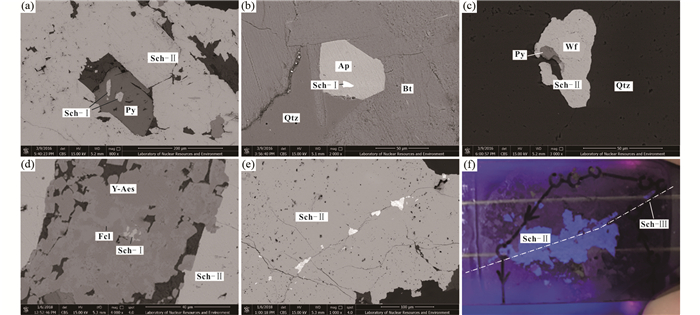
|
图 3 聚源钨矿三阶段白钨矿背散射及光薄片照片 Y-Aes-钇易解石;Fcl-铌铁矿;Py-黄铁矿;Wf-黑钨矿;Bt-黑云母;Ap-磷灰石;Sch-Ⅰ-第一阶段白钨矿;Sch-Ⅱ-第二阶段白钨矿;Sch-Ⅲ-第三阶段白钨矿 Fig. 3 BES and slice photos of three stage scheelites in the Juyuan tungsten deposit |
白钨矿的化学成分分析结果如表 1所示,第一阶段白钨矿由于含量少,且颗粒较小,此次实验没有测到其化学组成,以4个氧原子为基础计算其阳离子数,所得其实际化学式如下:
|
|
表 1 聚源钨矿中白钨矿与黑钨矿电子探针成分(wt%)及阳离子数 Table 1 Electron probe compositions (wt%) and cation numbers of scheelite and wolframite in the Juyuan tungsten deposit |
第二阶段(Ca0.993, Mg0.001, Fe0.002, Mn0.001)0.997(W, Nb0.001, Mo0.001)1.002O4
第三阶段(Ca0.990, Mg0.001, Fe0.002, Mn0.002)0.995(W1.001, Ta0.001, Nb0.001, Mo0.001)1.004O4
钨和钼由于电价相同,原子半径、离子半径以及络阴离子半径均十分接近,在结晶性质方面相似,二者在四次配位晶格位置上常进行类质同象置换,因此,白钨矿中钼一般较为富集(刘英俊和马东升,1987)。钨矿床中也常伴生钼,如:赣中的下桐岭钨矿、昆山钨钼铜矿床以及红花尔基白钨矿床等。白钨矿中,钼的含量也可高达1.22%~4.05%(赵一鸣等,1990;陈思佳等,2015)。然而聚源钨矿床白钨矿中钼的含量并不高,大多低于检测限,最高也只有0.14%,这可能是因为成矿流体中钼的浓度较低,或者结晶环境没有满足钼置换钨的条件。
3.1.2 黑钨矿聚源钨矿中黑钨矿含量不高,粒径从几十到上百微米不等,且明显被Sch-Ⅱ包裹(图 3c、图 4),表明黑钨矿形成时间在Sch-Ⅱ之前。黑钨矿理想化学式为(Fe, Mn)WO4,王濮等(1982)根据Fe、Mn相对原子比,将黑钨矿分为三个亚种:钨锰矿亚种((Fe0.0-0.2, Mn1.0-0.8)WO4或MnWO4)、钨锰铁矿亚种((Fe0.2-0.8, Mn0.8-0.2)WO4或(Fe, Mn)WO4或(Mn, Fe)WO4))、钨铁矿亚种((Fe0.8-1.0, Mn0.2-0.0)WO4或FeWO4)。据电子探针数据(表 1)计算得到聚源钨矿中黑钨矿实际化学式为(Fe0.813, Mn0.220, X0.028)1.061(W0.975, Z0.005)0.980O4(X=Mg, Ca;Z=Ta, Mo, Nb),归属于钨锰铁矿亚种。
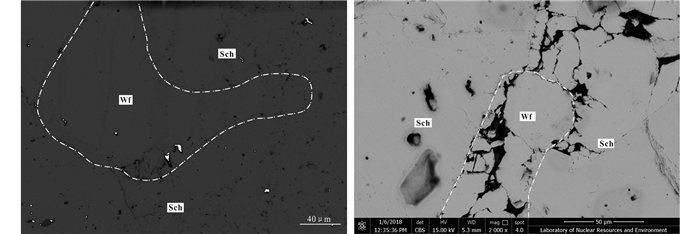
|
图 4 聚源钨矿白钨矿与黑钨矿伴生背散射电子图像 Fig. 4 BES photos of associated scheelite and wolframite in the Juyuan tungsten deposit |
骑田岭矿于1985年在骑田岭花岗岩中首次被发现(杨光明等,1985),其理想矿物分子式为(Fe, Mn)2(Nb, Ta)2WO10。除骑田岭之外,目前报道过的发现骑田岭矿的地方仅有四处:捷克Cínovec Sn-W-Li矿床以及巴西Breves Cu-Au-(W-Bi-Sn)矿床均在云英岩中发现该矿物,且Cínovec Sn-W-Li矿床、英格兰Hensbarrow黄玉花岗岩体以及中国湖南癞子岭在花岗岩中也发现骑田岭矿(Williamson et al., 1997, Tallarico et al., 2004;Breiter et al., 2017;Xie et al., 2018)。Xie et al.(2018)还发现骑田岭矿一般与铌铁矿族矿物、黑钨矿、钨铌铁矿生长在一起,但并没有明显的先后关系。
在聚源钨矿的研究过程中,同样发现了骑田岭矿,多生长于铌铁矿边部,以交代铌铁矿形式产出,颗粒较小(<20μm)(图 5a),化学组成如表 2,Nb2O5:41.76%~43.35%,FeO:12.85%~15.42%,MnO:3.63%~6.20%,Ta2O5:0.23%~0.38%,TiO2:3.75%~4.93%,WO3:26.74%~29.68%,UO2:0.08~0.27%。以10个氧原子为基础,计算该矿物阳离子数,得到该矿物的实际化学分子式为(Fe1.231, Mn0.422, Sc0.227, X0.152)2.032(Nb1.950, Ti0.346, Ta0.008)2.304W0.740O10,其中X=∑REE, Mg, Na, Al, Ba, Ca, Si, Sr, U, Th, Ba。
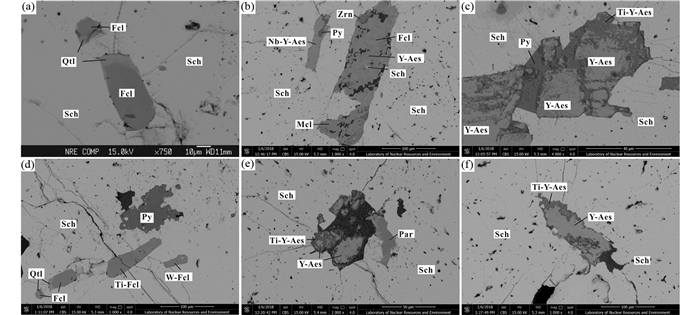
|
图 5 聚源钨矿含钨矿物背散射照片 Qtl-骑田岭矿;Zrn-锆石;Mcl-铌锰矿;Ti-Y-Aes-钛-钇易解石;Thr-钍石;Par-氟碳钙铈矿 Fig. 5 BSE photos of W- and U-bearing minerals in the Juyuan tungsten deposit |
|
|
表 2 聚源钨矿铌酸盐矿物电子探针分析结果(wt%) Table 2 Electron probe compositions (wt%) of niobate minerals in the Juyuan tungsten deposit |
聚源钨矿中的富钨含铀矿物有铌铁矿族矿物和易解石族矿物两大类,其化学成分复杂,均存在多个变种。
3.2.1 铌铁矿族矿物铌铁矿族矿物理想矿物分子式为(Fe, Mn)2(Nb, Ta)2O6,王濮等(1982)根据Fe、Mn和Nb、Ta原子百分数,将铌铁矿族矿物分为以下几个亚种:铌铁矿(Nb>Ta,Fe>Mn)、铌锰矿(Nb>Ta,Fe<Mn)、钽铁矿(Nb<Ta,Fe>Mn)、钽锰矿(Nb<Ta,Fe<Mn)。电子探针实验结果(表 2)表明,聚源铌铁矿族矿物Nb/(Ta+Nb)比值介于0.974~0.996之间,平均值为0.990,具有明显的富Nb贫Ta的特征,Fe/(Mn+Fe)比值在0.378~0.903范围内变化,主要集中在0.575~0.903之间,平均值为0.765,显示出较大的变化范围,总体上富铁。在铌铁矿族矿物亚种划分四方图解中(图 6)(饶灿,2009),聚源钨矿的铌铁矿族矿物测试数据主要落在铌铁矿区域,极少数落入铌锰矿区域,属于铌铁矿-铌锰矿组合。铌铁矿一般粒径小于100μm,可与易解石共生,而铌锰矿主要发育于铌铁矿边缘,以交代铌铁矿的方式产出(图 5b, d)。
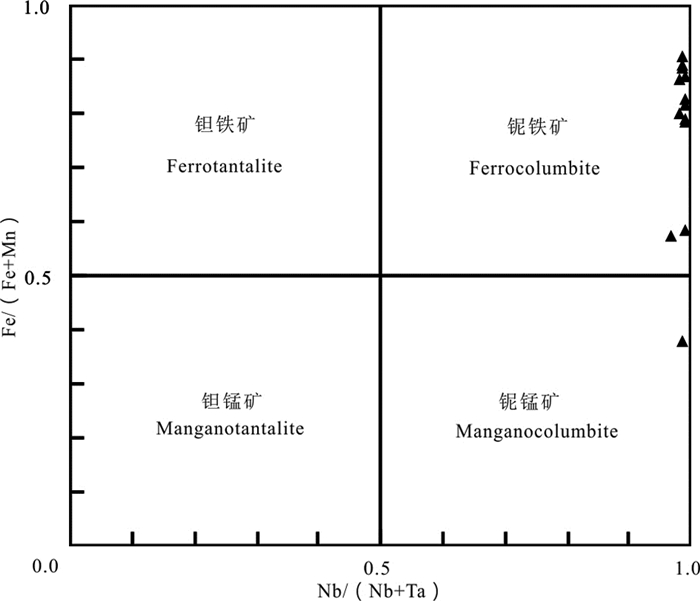
|
图 6 聚源钨矿铌铁矿族矿物亚种划分四方投影图解(据饶灿,2009) Fig. 6 Classification of the columbites in the Juyuan tungsten deposit (after Rao, 2009) |
王濮等(1982)还根据钛、钨和锡的富集特征,单独分出:钛-铌铁矿、钨-铌铁矿、锡-铌铁矿,聚源钨矿存在钛-铌铁矿(TiO2>10%)和钨-铌铁矿(WO3>10%)。计算出的铌铁矿族矿物实际化学分子式为:钛-铌铁矿(Fe0.625, Mn0.114, Si0.081, Y0.060, Sc0.054, Ca0.038, X0.109)1.081(Nb1.409, Ti0.497, W0.061, Ta0.012)1.979O6,X=∑REE, Na, Mg, Al, Th, Sr, Ba, U;钨-铌铁矿(Fe0.751, Mn0.192, Sc0.066, Dy0.023, Z0.054)1.086(Nb1.518, Ti0.263, W0.163, Ta0.018)1.962O6;铌铁矿(Fe0.747, Mn0.213, Sc0.039, Dy0.028, Z0.034)1.061(Nb1.766, Ti0.138, W0.054, Ta0.017)1.975O6;铌锰矿(Mn0.577, Fe0.351, Dy0.094, Sc0.023, Z0.040)1.085(Nb1.808, Ti0.086, W0.036, Ta0.017)1.947O6;Z=∑LREE, Na, Mg, Al, Th, Sr, Ba, U, Gd, Tb, Ho, Er, Tm, Yb, Lu, Si。
铌铁矿族矿物中大多含钨,但含量一般不会太高,Tarantino and Zema(2005)研究了多地的铌铁矿族矿物,WO3含量最高不超过0.96%,而聚源钨矿区中该矿物最高可达10.97%,显示其极有可能为一种新矿物,其出现可能是因为成矿流体中钨含量较高,具有相对充足的W与Nb、Ti之间进行类质同象置换。
铌铁矿族矿物中矿物不同程度含铀,其中铌铁矿UO2含量从低于检测限到0.21%,铌锰矿中UO2含量为0.04%, 钛铌铁矿的UO2含量为:0.33%~1.45%;钨铌铁矿的UO2含量为0.35%。
3.2.2 易解石族矿物易解石族矿物,分子通式为AB2O6,是一种富含Nb、Ti、Ta、REE的氧化物矿物,其阳离子之间有着普遍的类质同象置换关系,所以化学组成比较复杂,占据A位的元素一般包括∑Ce、∑Y、Fe、U、Th、Ca等,B位的元素一般包括Ti、Nb、Ta、W、Si等(王濮等,1982;张静,1988;Gieré and Williams,1992;杨主明等,2003)。聚源钨矿中发现了一类矿物,REE2O3总量在5.43%~39.57%之间,富Nb(Nb2O5含量为20.01%~49.53%)、Ti(TiO2含量在15.59%~49.13%之间)等元素,个别分析点Ti含量极低(TiO2含量为0.34%),可以判定为易解石族矿物。该类矿物粒径一般在200μm以下,多形成单独的矿物颗粒,偶见其与铌铁矿共生(图 5b)。
A位稀土元素主要为∑Ce或∑Y,据此可以将易解石族矿物分为两个矿物种,一般易解石稀土成分以Ce族为主,而钇易解石则以Y族稀土为主(王濮等,1982)。聚源钨矿区易解石族矿物有明显的富Y贫Ce的特征(表 2),属于钇易解石矿物种,计算出的分子式如下:(Y0.526, Ce0.049, Fe0.135, Ca0.117, U0.048, Mn0.020, Th0.013, Sc0.004, Ba, 0.008, Na0.004, Mg0.004)0.927(Nb0.908, Ti0.924, Si0.143, W0.077, Ta0.036)2.088O6。
易解石族矿物中常常出现复杂变种(王濮等,1982;张静,1988;Bonazzi and Zoppi, 2002;杨主明等,2003),此次研究发现一类富钛(32.36%~49.13%)贫REE(5.43%~10.49%)的特殊变种,称之为富钛钇易解石(表 2),实际化学式为:(Y0.143, Ce0.027, Fe0.270, Ca0.119, U0.044, Na0.030, Th0.018, Mg0.015, Mn0.014, Ba, 0.008, Sc0.002)0.690(Ti1.594, Nb0.499, Si0.264, W0.038, Ta0.035)2.430O6。
易解石族矿物中钨的含量通常很低,虽然之前有许多学者对该矿物进行过研究(TomaŠiĆ et al., 2004; Ma et al., 2007; Savelyeva et al., 2017),该矿物中的钨却并没有受到过多关注。从已有的研究来看,加拿大Thor Lake稀有金属矿床和Kamloops矿区碳酸盐岩中易解石的WO3含量较低,最高含量分别为0.19%和0.06%;捷克Třebíč深成岩体以及意大利Garnet Codera伟晶岩岩脉中易解石的WO3含量稍高,最高分别可以达到1.37%和1.85%;Bonazzi and Menchetti(1999)研究了意大利四个地区钇易解石,WO3含量在2.14%~7.25%之间(Pinckston and Smith, 1995;Bonazzi and Menchetti, 1999;Škoda and Novák,2007;Morrison et al., 2012;Capitani et al., 2016)。
聚源钨矿易解石WO3含量介于1.63%~9.80%之间,这一含量高于大多数地区的易解石,非常富钨。聚源钨矿易解石族矿物中富钨的原因可能为成矿流体中钨的浓度更高。
从分析结果上看,聚源钨矿的易解石族矿物极度富铀,其中钇易解石中UO2含量:0.45%~7.55%,钛-钇易解石UO2含量:2.78%~4.73%。
4 讨论钨是一种重要的战略性资源,而江西地区是我国重要的钨矿产地。赣南地区钨多以黑钨矿形式存在,如西华山钨矿、茅坪钨矿、漂塘钨矿等,向北白钨矿比重逐渐上升,如香炉山钨矿,大湖塘钨矿,甚至在赣中地区出现了聚源石英脉型白钨矿床,钨平均品位约为WO3:0.245%,WO3资源量126182吨(江西有色地质勘查一队, 2015),工业规模达到大型。这种矿床类型较为特殊,在整个华南地区也实属罕见。
4.1 富钨含铀铌酸盐矿物的结晶时段及其地质意义钨矿床的形成往往具有多期多阶段性(张勇等,2019),通过对聚源钨矿白钨矿石开展矿相学及精细矿物学等方面的研究,可以发现一些较为明显的交代、穿插现象,如第二阶段白钨矿交代黑钨矿(图 3c、图 4),骑田岭矿交代铌铁矿(图 5a),黄铁矿穿插钇易解石、钛-钇易解石(图 5c, d),钛-钇易解石交代钇易解石(图 5c, e, f),钍石交代锆石(图 7a, b),黄铁矿包裹钍石(图 7c, d),黄铁矿穿切磷灰石(图 7e),钍石包裹磷灰石(图 7f)。
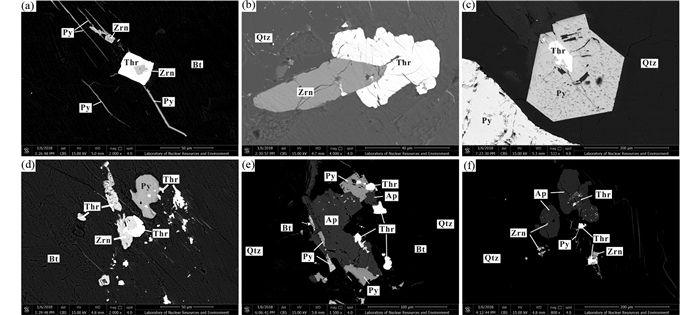
|
图 7 聚源钨矿中部分副矿物背散射电子图像 Fig. 7 BSE photos of some accessory minerals from Juyuan tungsten deposits |
根据这些特征,聚源钨矿中钨的成矿过程可划分为四个阶段(图 8):第一阶段,钨以类质同象的形式进入铌铁矿、钇易解石等富钨矿物,这些矿物同时还具有不同程度富铀的特征,另外,极少量的钨形成了黑钨矿和斑点状白钨矿;第二阶段,流体对第一阶段形成的矿物进行交代,在此过程中铌铁矿被进一步交代形成骑田岭矿以及铌锰矿,有的学者将骑田岭矿称为“富钨铌铁矿”(Johan and Johan, 1994),且此次研究发现骑田岭矿多生长于铌铁矿边部以交代铌铁矿形式产出(图 5a),也印证了这一观点。而流体中的Ti与钇易解石中的Nb进行置换,在钇易解石边部则会出现富钛环边,形成变种钛-钇易解石。易解石族矿物B位的Nb和(Ti+Si)在含量上存在明显的此消彼长关系,呈负相关(图 9),这也说明了Nb和Ti在矿物晶格中占有相同的位置,印证了之前的结论;第三阶段,钨形成主要矿石矿物Sch-Ⅱ,这一阶段也是钨的最主要的矿化阶段;第四阶段,钨以极细的脉状白钨矿形式矿化,且对Sch-Ⅱ有明显的穿插(图 3f)。
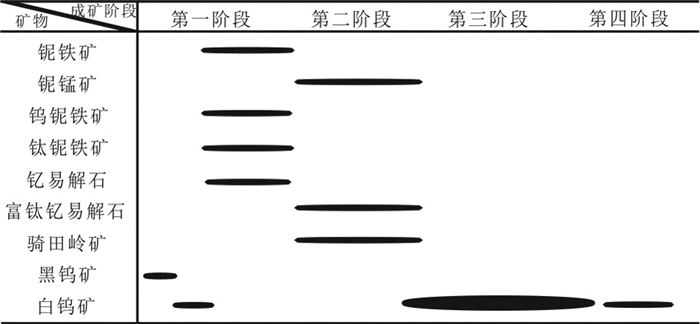
|
图 8 聚源钨矿中含钨矿物的成矿过程示意图 Fig. 8 Diagram of metallogenic process of tungsten bearing minerals in the Juyuan tungsten deposit |
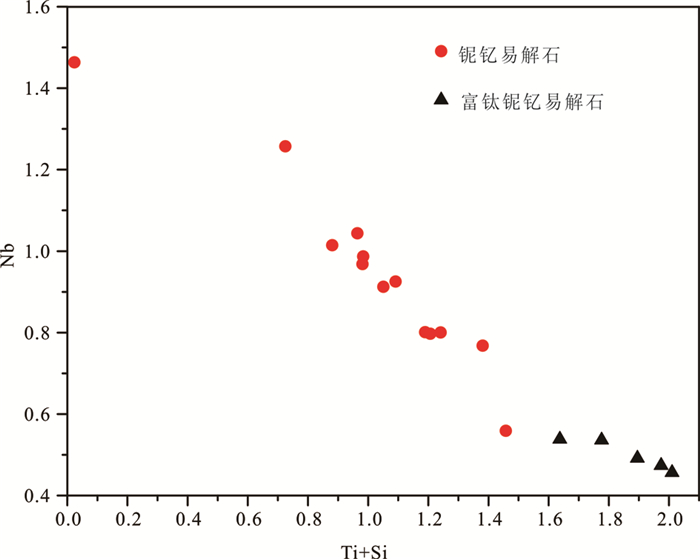
|
图 9 聚源钨矿易解石族矿物Nb-(Ti+Si)含量相关性图解 Fig. 9 Nb vs. Ti+Si correlation of aeschynites in the Juyuan tungsten deposit |
以上说明,成矿流体演化的过程中,铌酸盐矿物结晶早于钨的主成矿阶段,这一过程中钨和铀同在铌酸盐矿物中有所富集。
钨与铌钽伴生的矿床,空间上铌钽与深部蚀变岩体关系更为密切,而钨不仅可以与深部岩体空间上叠置,而且在外接触带可以形成更富的石英脉型矿化。典型的如:横峰葛源稀有金属矿床从上部到下部,依次发育有细脉带型钨锡矿,细脉带型钼钨矿,伟晶岩“壳”型铌钽多金属矿,云英岩化花岗岩型铌钽矿化,钠长石化花岗岩型铌钽矿化(伴生钨)(江西有色地质矿产勘查开发院,2018①);大吉山钨矿,上部发育脉型钨矿,而深部的“69号岩体”则为铌钽矿体。这种空间上的关系,很可能是时间关系的间接反应,可能与铌酸盐相对较早结晶有关,因为对于岩浆热液体系而言,钾长石化、钠长石化、云英岩化通常较石英脉的形成更早。
① 江西有色地质矿产勘查开发院.2018.江西省横峰县松树岗矿区钽铌矿勘探报告
值得注意的是铌钽铁矿中可以含WO3高达2.83%,钽铌铁矿中WO3含量稍低,也可达到0.75%(曾庆友等,2020)。铌钽矿中伴生铀的情况也屡见不鲜,典型的如:我国内蒙的801铌钽稀土多金属矿,伴生的铀已可以综合利用(齐玲和张辑,2020)。而葛源铌钽矿中的细晶石中UO2可以高达12.15%(曾庆友等,2020)。冶炼铌钽矿的炉渣中高度富集U和W(黄膑,2020)。这些现象均反映了铌钽矿物对钨和铀的富集作用,今后勘探铌钽矿的过程中可增加对钨铀的综合评价。
4.2 含钨矿物种类及其形成原因初探钨在元素周期表中位于第六周期第Ⅵ副族,地壳条件下大多以+6价存在(Ertel et al., 1996)。在六次配位晶格位置上W6+经常与Nb5+、Ta5+和Ti4+发生类质同象置换,而在四次配位晶格位置上可以与Mo6+发生置换(刘英俊和马东升,1987;Belkasmi et al., 2000;Huang et al., 2002),因此,含钨矿物种类较多,其中,钨矿石中比较常见的有白钨矿(CaWO4)、黑钨矿((Mn, Fe)WO4),另外还有骑田岭矿((Fe, Mn)2(Nb, Ta)2WO10)、钼白钨矿(Ca(W, Mo)O4)、钨铅矿(PbWO4)以及钨铋矿(BiWO4)等。
富钨矿物中的W常以类质同象置换的方式进入矿物晶格,如:铌铁矿族矿物、易解石族矿物、黑稀金矿、细晶石等,这些矿物通常还富铀钍以及稀土元素。
此次在聚源钨矿中发现的含钨矿物种类也比较丰富,钨矿物主要有白钨矿、黑钨矿、骑田岭矿,而富钨矿物有铌铁矿族矿物和易解石族矿物等。其中易解石族矿物均为钇易解石,且产生少量变种,变种中Ti元素含量较高,Nb、REE随之减少,称之为钛-钇易解石。钛-钇易解石与钇易解石空间关系较为密切,多存在于钇易解石边缘部分或裂隙中。在背散射电子图像中,由于钛-钇易解石相较于钇易解石稀土元素较亏损而略暗于钇易解石,呈包裹状(图 5c, e, f)。而铌铁矿族矿物有铌铁矿和铌锰矿两个矿物种,且部分铌铁矿变生为钛-铌铁矿和钨-铌铁矿。除了黑钨矿与白钨矿之外,骑田岭矿、铌铁矿族矿物与易解石族矿物均不同程度表现出富铀的特征。
4.3 铌铁矿与易解石变种及形成原因在自然界中,铌铁矿族矿物与易解石族矿物均易形成变种,这是由于W与Nb、Ti之间存在普遍的类质同象置换关系,这一点通过元素周期表对角线规则也可以得到验证,W与Nb、Ti呈对角线位置关系,呈现相似性。除此之外,变价Fe、U和REE的氧化会造成化合价升高,为了维持电价守恒,其他价态较低的离子含量随之增加,导致矿物化学成分发生改变。再有,放射性元素U和Th的衰变也会影响矿物晶格的稳定性,形成矿物变种。而易解石族矿物颗粒周围常出现放射状裂隙(图 4c, f、图 7d),这也与U和Th的衰变有直接关系。易解石晶体结构允许放射性元素U和Th的进入,U和Th进行放射性衰变,产生α粒子,造成矿物蜕晶化,矿物体积膨胀,从而形成放射状裂隙(陶克捷和张培善,1994)。
5 结论(1) 聚源钨矿中的含钨矿物分为钨矿物和富钨矿物。钨矿物包括白钨矿、黑钨矿、骑田岭矿;富钨矿物包括铌铁矿、钛-铌铁矿、钨-铌铁矿、铌锰矿、钇易解石、钛-钇易解石,其中骑田岭矿与铌锰矿是铌铁矿进一步交代的结果,钛-钇易解石是钇易解石进一步交代的结果,另外骑田岭矿是除白钨矿和黑钨矿之外钨含量最高的含钨矿物。
(2) 钨的成矿分为四个阶段:第一个阶段,钨进入富含Nb、Ti的氧化物矿物,形成铌铁矿、钇易解石等富钨矿物,另外还有极少量的钨进入黑钨矿和斑点状白钨矿;第二个阶段,铌铁矿与钇易解石被后期流体交代形成骑田岭矿、铌锰矿以及钛-钇易解石;第三个阶段,钨进入Sch-Ⅱ,这也是钨最主要的存在形式;第四个阶段,钨进入脉状白钨矿。在成矿流体演化过程中,绝大多数W首先进入的是富含Nb、Ti的氧化物矿物和黑钨矿,白钨矿在其后形成。
(3) 铌铁矿族矿物、易解石族矿物变种的形成因素主要有W与Nb、Ti之间的类质同象置换关系,变价Fe、U和REE的氧化以及放射性元素U和Th的衰变。U和Th的衰变还会造成易解石周围出现放射状的裂隙。
致谢 江西省有色地质勘查局有色一队的周先军总工以及聚源钨矿的领导在野外工作期间提供了大量帮助;浙江大学饶灿教授指导了实验数据的解释;东华理工大学张展适教授参与了成文过程的讨论;研究生刘朕语、陈光旭和宋炎指导了部分实验;匿名审稿人提出了宝贵的修改意见;谨向以上单位和个人致以诚挚的谢意。
Belkasmi M, Cuney M, Pollard PJ and Bastoul A. 2000. Chemistry of the Ta-Nb-Sn-W oxide minerals from the Yichun rare metal granite (SE China): Genetic implications and comparison with Moroccan and French Hercynian examples. Mineralogical Magazine, 64(3): 507-523 DOI:10.1180/002646100549391
|
Bermanec V, TomaŠiĆ N, Kniewald G, Back ME and Zagler G. 2008. Nioboaeschynite-(Y), a new member of the aeschynite group from the Bear Lake diggings, Haliburton County, Ontario, Canada. The Canadian Mineralogist, 46(2): 395-402 DOI:10.3749/canmin.46.2.395
|
Bonazzi P and Menchetti S. 1999. Crystal chemistry of aeschynite-(Y) from the Western Alps: Residual electron density on difference-Fourier map. European Journal of Mineralogy, 11(6): 1043-1049 DOI:10.1127/ejm/11/6/1043
|
Bonazzi P and Zoppi M. 2002. Metamict aeschynite-(Y) from the Evje-Iveland district (Norway): Heat-induced recrystallization and dehydrogenation. European Journal of Mineralogy, 14(1): 141-150 DOI:10.1127/0935-1221/2002/0014-0141
|
Breiter K, Korbelová Z, Chládek Š, Uher P, Knesl I, Rambousek P, Honig S and Šešulka V. 2017. Diversity of Ti-Sn-W-Nb-Ta oxide minerals in the classic granite-related magmatic-hydrothermal Cínovec/Zinnwald Sn-W-Li deposit (Czech Republic). European Journal of Mineralogy, 29(4): 727-738 DOI:10.1127/ejm/2017/0029-2650
|
Capitani GC, Mugnaioli E and Guastoni A. 2016. What is the actual structure of samarskite-(Y)? A TEM investigation of metamict samarskite from the Garnet Codera dike pegmatite (Central Italian Alps). American Mineralogist, 101(7): 1679-1690 DOI:10.2138/am-2016-5605
|
Chen SJ, Guo MY, Ke HP, Lin XZ and Liu Y. 2015. Component characteristics of scheelite in Nanyangtian, Yunnan Province and Dingjiashan, Fujian Province. Geology of Fujian, 34(3): 171-180 (in Chinese with English abstract)
|
Ercit TS. 2005. Identification and alteration trends of granitic-pegmatite-hosted (Y, REE, U, Th)-(Nb, Ta, Ti) oxide minerals: A statistical approach. The Canadian Mineralogist, 43(4): 1291-1303 DOI:10.2113/gscanmin.43.4.1291
|
Ertel W, O'Neill HSC, Dingwell DB and Spettel B. 1996. Solubility of tungsten in a haplobasaltic melt as a function of temperature and oxygen fugacity. Geochimica et Cosmochimica Acta, 60(7): 1171-1180 DOI:10.1016/0016-7037(96)00022-1
|
Fan HR, Chen FK, Wang KY, Xie YH, Wilde S and Satir M. 2002. Zircon U-Pb age of a carbonatite dyke from Bayan Obo REE-Fe-Nb deposit, Inner Mongolia and its geological significance. Acta Petrologica Sinica, 18(3): 363-368 (in Chinese with English abstract)
|
Gieré R and Williams CT. 1992. REE-bearing minerals in a Ti-rich vein from the Adamello contact aureole (Italy). Contributions to Mineralogy and Petrology, 112(1): 83-100 DOI:10.1007/BF00310957
|
Harlaux M, Marignac C, Cuney M, Mercadier J, Magott R and Mouthier B. 2015. Nb-Ti-Y-HREE-W-U oxide minerals with uncommon compositions associated with the tungsten mineralization in the Puy-Les-Vignes deposit (Massif Central, France): Evidence for rare-metal mobilization by late hydrothermal fluids with a peralkaline signature. The Canadian Mineralogist, 53(4): 653-672 DOI:10.3749/canmin.1400096
|
Huang B. 2020. Radioactive pollution and activity calculation method in tantalum niobium ore smelting. Energy Research and Management, (3): 91-95 (in Chinese with English abstract)
|
Huang HL, Chang HL, Tan J, Li F, Zhang CH and Zhou Y. 2015. Contrasting infrared microthermometry study of fluid inclusions in coexisting quartz, wolframite and other minerals: A case study of Xihuashan quartz-vein tungsten deposit, China. Acta Petrologica Sinica, 31(4): 925-940 (in Chinese with English abstract)
|
Huang XL, Wang RC, Chen XM, Hu H and Liu CS. 2002. Vertical variations in the mineralogy of the Yichun topaz-lepidolite granite, Jiangxi Province, southern China. The Canadian Mineralogist, 40(4): 1047-1068 DOI:10.2113/gscanmin.40.4.1047
|
Jiangxi Volume Editing Committee. 2015. Mineral Geology of China-Jiangxi Ⅰ, Ⅱ. Beijing: Geological Publishing House (in Chinese)
|
Johan V and Johan Z. 1994. Accessory minerals of the Cínovec (Zinnwald) granite cupola, Czech Republic Part 1:Nb-, Ta- and Ti-bearing oxides. Mineralogy and Petrology, 51(2-4): 323-343 DOI:10.1007/BF01159735
|
Li GL, Hua RM, Huang XE, Wei XL, Qu WJ and Wang XD. 2011. Re-Os isotopic age of molybdenite from Xiatongling tungsten deposit, central Jiangxi Province, and its geological implications. Mineral Deposits, 30(6): 1075-1084
|
Liu SB, Liu ZQ, Wang CH, Wang DH, Zhao Z and Hu ZH. 2017. Geochemical characteristics of REEs and trace elements and Sm-Nd dating of scheelite from the Zhuxi giant tungsten deposit in northeast Jiangxi. Earth Science Frontiers, 24(5): 17-30 (in Chinese with English abstract)
|
Liu YJ and Ma DS. 1987. Geochemistry of Tungsten. Beijing: Science Press (in Chinese)
|
Ma Q, Zhang AY, Lü MK, Zhou YY, Qiu ZF and Zhou GJ. 2007. Novel class of aeschynite structure LaNbTiO6-based orange-red phosphors via a modified combustion approach. The Journal of Physical Chemistry B, 111(44): 12693-12699 DOI:10.1021/jp0739162
|
Morrison SM, Downs RT, Domanik KJ, Yang H and Doell D. 2012. Nioboaeschynite-(Ce), Ce(NbTi)O6. Acta Crystallographica, E68: i64-i65
|
Orhan A. 2017. Evolution of the Mo-rich scheelite skarn mineralization at Kozbudaklar, western Anatolia, Turkey: Evidence from mineral chemistry and fluid inclusions. Ore Geology Reviews, 80: 141-165 DOI:10.1016/j.oregeorev.2016.06.029
|
Peng ZZ, Wang S, Ma ZS and Yang GM. 1987. The crystal structure of Qitianlingite Fe2Nb2WO10. Chinese Science Bulletin, 33(10): 856-861
|
Pieczka A. 2010. Primary Nb-Ta minerals in the Szklary pegmatite, Poland: New insights into controls of crystal chemistry and crystallization sequences. American Mineralogist, 95: 1478-1492 DOI:10.2138/am.2010.3321
|
Pinckston DR and Smith DGW. 1995. Mineralogy of the Lake zone, Thor Lake rare-metals deposit, N.W.T., Canada. Canadian Journal of Earth Sciences, 32(4): 516-532 DOI:10.1139/e95-044
|
Qi L and Zhang J. 2020. Uncertainty assessment on uranium detection in Uranium mine 801 with MUA model trace uranium analyzer. World Nuclear Geoscience, 37(1): 53-57 (in Chinese with English abstract)
|
Qin Y, Zhang WZ, Peng PA and Zhou ZJ. 2009. Occurrence and concentration of uranium in the hydrocarbon source rocks of Chang 7 Member of Yanchang Formation, Ordos basin. Acta Petrologica Sinica, 25(10): 2469-2476 (in Chinese with English abstract)
|
Rao C. 2009. Mineralogical study and magma hydrothermal evolution tracing of granitic pegmatite No. 31 in Nanping, Fujian Province. Ph. D. Dissertation. Nanjing: Nanjing University (in Chinese with English summary)
|
Rossoni MB, Bastos AC, Souza VS, Marques JC, Dantas E and Botelho NF. 2017. U-Pb zircon geochronological investigation on the Morro dos Seis Lagos Carbonatite Complex and associated Nb deposit (Amazonas, Brazil). Journal of South American Earth Sciences, 80: 1-17 DOI:10.1016/j.jsames.2017.09.021
|
Savelyeva VB, Bazarova EP, Sharygin VV, Karmanov NS and Kanakin SV. 2017. Altered rocks of the Onguren carbonatite complex in the Western Tansbaikal Region: Geochemistry and composition of accessory minerals. Geology of Ore Deposits, 59(4): 315-340 DOI:10.1134/S1075701517040055
|
Škoda R and Novák M. 2007. Y, REE, Nb, Ta, Ti-oxide (AB2O6) minerals from REL-REE euxenite-subtype pegmatites of the Třebíč Pluton, Czech Republic: Substitutions and fractionation trends. Lithos, 95(1-2): 43-57 DOI:10.1016/j.lithos.2006.07.020
|
Tallarico FHB, McNaughton NJ, Groves DI, Fletcher IR, Figueiredo BR, Carvalho JB, Rego JL and Nunes AR. 2004. Geological and SHRIMP Ⅱ U-Pb constraints on the age and origin of the Breves Cu-Au-(W-Bi-Sn) deposit, Carajás, Brazil. Mineralium Deposita, 39(1): 68-86 DOI:10.1007/s00126-003-0383-y
|
Tao KJ and Zhang PS. 1994. Charaeteristies of metamiet aeschynites. Acta Petrologica et Mineralogica, 13(1): 67-77 (in Chinese with English abstract)
|
Tarantino SC and Zema M. 2005. Mixing and ordering behavior in manganocolumbite-ferrocolumbite solid solution: A single-crystal X-ray diffraction study. American Mineralogist, 90: 1291-1299 DOI:10.2138/am.2005.1641
|
TomaŠiĆ N, GajoviĆ A, Bermanec V and RajiĆ M. 2004. Recrystallization of metamict Nb-Ta-Ti-REE complex oxides: A coupled X-ray-diffraction and Raman spectroscopy. Study of aeschynite-(Y) and polycrase-(Y). Canadian Mineralogist, 42(6): 1847-1857
|
Wang CL, Qing KZ, Zhou QF and Tang DM. 2014. Contribution of multiple magmatism to the formation of Li-Be-Nb-Ta pegmatites: Evidence from zircon U-Pb ages in the Kelumute-Jideke pegmatite field, northwestern China. Acta Geologica Sinica, 88(S2): 468-469 DOI:10.1111/1755-6724.12373_26
|
Wang P, Pan ZL and Weng LB. 1982. Systematic Mineralogy (Ⅰ). Beijing: Geological Publishing House (in Chinese)
|
Williamson BJ, Stanley CJ and Wilkinson JJ. 1997. Implications from inclusions in topaz for greisenisation and mineralization in the Hensbarrow topaz granite, Cornwall, England. Contributions to Mineralogy and Petrology, 127(1-2): 119-128 DOI:10.1007/s004100050269
|
Wu MQ, Samson IM and Zhang DH. 2017. Textural and chemical constraints on the formation of disseminated granite-hosted W-Ta-Nb mineralization at the Dajishan deposit, Nanling Range, southeastern China. Economic Geology, 112(4): 855-887 DOI:10.2113/econgeo.112.4.855
|
Xie L, Wang ZJ, Wang RC, Zhu JC, Che XD, Gao JF and Zhao X. 2018. Mineralogical constraints on the genesis of W-Nb-Ta mineralization in the Laiziling granite (Xianghualing district, South China). Ore Geology Reviews, 95: 695-712 DOI:10.1016/j.oregeorev.2018.03.021
|
Xiong DX, Sun XM, Shi GY, Wang SW, Gao JF and Xue T. 2006. Trace elements, rare earth elements (REE) and Nd-Sr isotopic compositions in scheelites and their implications for the mineralization in Daping gold mine in Yunnan Province, China. Acta Petrologica Sinica, 22(3): 733-741 (in Chinese with English abstract)
|
Xu KQ, Liu YJ and Yu SY. 1959. Types and distribution of tungsten deposits in China. Journal of Nanjing University (Natural Science), (2): 31-49 (in Chinese)
|
Yang GM, Wang S, Peng Z and Bu JZ. 1985. Qitianlingite: A newly discovered superstructure complex oxide. Acta Mineralogica Sinica, 5(3): 3-8 (in Chinese with English abstract)
|
Yang MG and Mei YW. 1997. Characteristics of geology and metallization in the Qinzhou-Hangzhou paleo-plate juncture. Geology and Mineral Resources of South China, (3): 52-59 (in Chinese with English abstract)
|
Yang ZM, Song RK, Tao KJ and Zhang PS. 2003. Rare earth compositional variation of aeschynite-group minerals. Journal of the Chinese Rare Earth Society, 21(6): 716-720 (in Chinese with English abstract)
|
Yu DG, Guan TY, Wu JH, Wang Y and Wu RG. 2006. The review of new development of basic geology research in Jiangxi Province. Journal of East China Institute of Technology, (Suppl.1): 1-11 (in Chinese with English abstract)
|
Zahid M, Arif M and Moon CJ. 2013. Petrogenetic implications of the mineral-chemical characteristics of scheelite and associated phases from Miniki Gol (Chitral), NW Pakistan. Geosciences Journal, 17(4): 403-416 DOI:10.1007/s12303-013-0035-x
|
Zeng QY, Pan SY, Peng ST and Yu HF. 2020. Technological mineralogical characteristics of Songshugang albitized granitie type tantalum-niobium ore in Jiangxi Province. Multipurpose Utilization of Mineral Resources, (6): 180-185 (in Chinese with English abstract)
|
Zhang AC, Wang RC, Hu H, Zhang H, Zhu JC and Xie L. 2004. The complex zonation of columbite-group minerals from the Koktokay No. 3 granitic pegmatite dyke, Altay, NW China and its petrological implications. Acta Geologica Sinica, 78(2): 181-189 (in Chinese with English abstract)
|
Zhang J. 1988. Chemical characteristics of aeschynite group minerals. Journal of the Chinese Rare Earth Society, 6(2): 63-67 (in Chinese with English abstract)
|
Zhang Q, Zhang RQ, Gao JF, Lu JJ and Wu JW. 2018. In-situ LA-ICP-MS trace element analyses of scheelite and wolframite: Constraints on the genesis of veinlet-disseminated and vein-type tungsten deposits, South China. Ore Geology Reviews, 99: 166-179 DOI:10.1016/j.oregeorev.2018.06.004
|
Zhang Y, Liu NQ, Pan JY and YIN H. 2019. Multi-mineralization stages of the Shimensi giant tungsten deposit of Northwest Jiangxi: The application of cumulative frequency distribution in tungsten ore genesis and ore prospecting. Journal of East China University of Technology (Natural Science), 42(4): 334-341 (in Chinese with English abstract)
|
Zhao FM, Chen ZR, Zhang JY and Wang WG. 1988. Manual of Uranium Mineral Identification. Beijing: Atomic Energy Press (in Chinese)
|
Zhao YM, Lin WW, Bi CS, Li DX and Jiang CJ. 1990. Skarn Deposits in China. Beijing: Geological Publishing House (in Chinese)
|
陈思佳, 郭敏毅, 柯鸿沛, 林宪浈, 刘羽. 2015. 云南南秧田与福建丁家山白钨矿成分特征对比研究. 福建地质, 34(3): 171-180. DOI:10.3969/j.issn.1001-3970.2015.03.001 |
范宏瑞, 陈福坤, 王凯怡, 谢奕汉, Wilde S, Satir M. 2002. 白云鄂博REE-Fe-Nb矿床酸岩墙锆石U-Pb年龄及其地质意义. 岩石学报, 18(3): 363-368. |
黄膑. 2020. 钽铌矿冶炼中的放射性污染及活度计算方法. 能源研究与管理, (3): 91-95. |
黄惠兰, 常海亮, 谭靖, 李芳, 张春红, 周云. 2015. 共生黑钨矿与石英等多种矿物中流体包裹体的红外显微测温对比研究: 以江西西华山石英脉钨矿床为例. 岩石学报, 31(4): 925-940. |
江西省矿产地质志编辑委员会. 2015. 中国矿产地质志(江西卷上、下). 北京: 地质出版社.
|
李光来, 华仁民, 黄小娥, 韦星林, 屈文俊, 王旭东. 2011. 赣中下桐岭钨矿辉钼矿Re-Os年龄及其地质意义. 矿床地质, 30(6): 1075-1084. DOI:10.3969/j.issn.0258-7106.2011.06.008 |
刘善宝, 刘战庆, 王成辉, 王登红, 赵正, 胡正华. 2017. 赣东北朱溪超大型钨矿床中白钨矿的稀土、微量元素地球化学特征及其Sm-Nd定年. 地学前缘, 24(5): 17-30. |
刘英俊, 马东升. 1987. 钨的地球化学. 北京: 科学出版社.
|
彭志忠, 汪苏, 马喆生, 杨光明. 1987. 骑田岭矿Fe2Nb2WO10的晶体结构. 科学通报, 32(10): 759-762. |
齐玲, 张辑. 2020. MUA型微量铀分析仪测定801矿铀的不确定度评定. 世界核地质科学, 37(1): 53-57. DOI:10.3969/j.issn.1672-0636.2020.01.007 |
秦艳, 张文正, 彭平安, 周振菊. 2009. 鄂尔多斯盆地延长组长7段富铀烃源岩的铀赋存状态与富集机理. 岩石学报, 25(10): 2469-2476. |
饶灿. 2009. 福建南平31号花岗伟晶岩的矿物学研究与岩浆-热液演化示踪. 博士学位论文. 南京: 南京大学
|
陶克捷, 张培善. 1994. 变生易解石的特性. 岩石矿物学杂志, 13(1): 67-77. |
王濮, 潘兆橹, 翁玲宝. 1982. 系统矿物学-上册. 北京: 地质出版社.
|
熊德信, 孙晓明, 石贵勇, 王生伟, 高剑锋, 薛婷. 2006. 云南大坪金矿白钨矿微量元素、稀土元素和Sr-Nd同位素组成特征及其意义. 岩石学报, 22(3): 733-741. |
徐克勤, 刘英俊, 俞受鋆. 1959. 中国钨矿的类型及其分布规律. 南京大学学报(自然科学版), (2): 31-49. |
杨光明, 汪苏, 彭志忠, 卜静贞. 1985. 骑田岭矿: 新发现的一种超结构复杂氧化物. 矿物学报, 5(3): 3-8. |
杨明桂, 梅勇文. 1997. 钦-杭古板块结合带与成矿带的主要特征. 华南地质与矿产, (3): 52-59. |
杨主明, 宋仁奎, 陶克捷, 张培善. 2003. 易解石族矿物的稀土成分变化特征. 中国稀土学报, 21(6): 716-720. DOI:10.3321/j.issn:1000-4343.2003.06.023 |
余达淦, 管太阳, 巫建华, 王勇, 吴仁贵. 2006. 江西基础地质研究新进展述评. 东华理工学院学报, (增1): 1-11. |
曾庆友, 潘世语, 彭蜀涛, 俞寒飞. 2020. 江西松树岗钠长石化花岗岩型钽铌矿工艺矿物学特征. 矿产综合利用, (6): 180-185. DOI:10.3969/j.issn.1000-6532.2020.06.030 |
张爱铖, 王汝成, 胡欢, 张辉, 朱金初, 谢磊. 2004. 阿尔泰可可托海3号伟晶岩脉中铌铁矿族矿物环带构造及其岩石学意义. 地质学报, 78(2): 181-189. DOI:10.3321/j.issn:0001-5717.2004.02.006 |
张静. 1988. 易解石族矿物的化学特征. 中国稀土学报, 6(2): 63-67. DOI:10.3321/j.issn:1000-4343.1988.02.013 |
张勇, 刘南庆, 潘家永, 尹浩. 2019. 赣西北石门寺超大型钨矿床多期成矿作用: 累积概率格纸在钨矿成因及找矿中的应用. 东华理工大学学报(自然科学版), 42(4): 334-341. DOI:10.3969/j.issn.1674-3504.2019.04.005 |
赵凤民, 陈璋如, 张静宜, 王文广. 1988. 铀矿物鉴定手册. 北京: 原子能出版社.
|
赵一鸣, 林文蔚, 毕承思, 李大新, 蒋崇俊. 1990. 中国矽卡岩矿床. 北京: 地质出版社, 213-231.
|
 2021, Vol. 37
2021, Vol. 37


